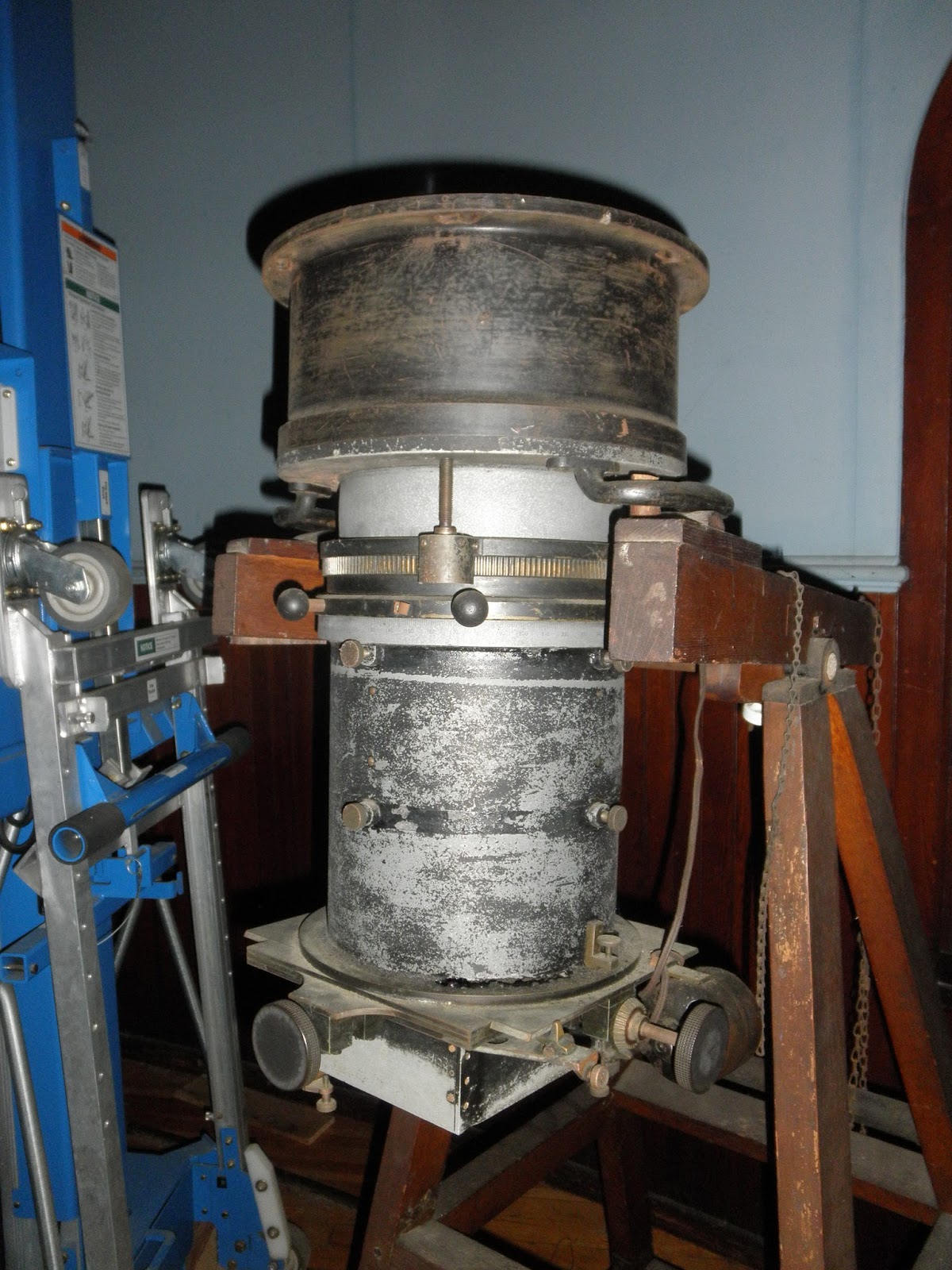 |
| I had to get my picture with the weather instruments, too. |
 On the top of "Mount" Jefferson sits the McCormick Observatory. (Mount is in quotes because I'm from Utah. It only took three minutes to walk to the top of this "mount.") This 26-inch telescope was built in 1884 and was the largest telescope in the United States (it had a twin at the U.S. Naval Observatory in Washington).
On the top of "Mount" Jefferson sits the McCormick Observatory. (Mount is in quotes because I'm from Utah. It only took three minutes to walk to the top of this "mount.") This 26-inch telescope was built in 1884 and was the largest telescope in the United States (it had a twin at the U.S. Naval Observatory in Washington).
I was impressed with the mechanics of the building. Many of the moving parts in the dome are still operated by ropes and pulleys, though, some electric motors have been added.

 Outside on top of the "dog house" were two other telescopes--a 10-inch telescope pointed at Saturn and a 6-inch telescope pointed at the moon. I was surprised how crisp the images were. I've seen the moon many times, but I could see so much detail when looking through the telescope. When I first looked at Saturn I was expecting to see a bright spot in the view, but I was blown away with what I saw--rings, around a large planet. Yeah, everyone knows that Saturn has rings, but I actually saw the rings around Saturn!
Outside on top of the "dog house" were two other telescopes--a 10-inch telescope pointed at Saturn and a 6-inch telescope pointed at the moon. I was surprised how crisp the images were. I've seen the moon many times, but I could see so much detail when looking through the telescope. When I first looked at Saturn I was expecting to see a bright spot in the view, but I was blown away with what I saw--rings, around a large planet. Yeah, everyone knows that Saturn has rings, but I actually saw the rings around Saturn!
I stole these pictures from the internet, but I wanted you to see what I saw through these telescopes:

Since Earth is spinning, the stars rise and set from east to west, just like our sun. After a few minutes of looking at a single star or planet the telescope's position has to be adjusted to account for the motion. The entire dome, telescope, and viewing platform can be moved when needed. In the short time waiting for my turn to look in the eye piece, the platform had moved twelve feet (past the door shown in the above picture).
The image above and on the left shows some old clockwork used to track the motion of the stars or planets. The image on the right shows an attachment used to take pictures. This device would take pictures by exposing the film on glass plates. One major projects started in 1914 that used this telescope analysed the film to calculate the distance of nearby stars.
Tonight the telescope was pointed at Mars. I can testify that that planet is red.
 Outside on top of the "dog house" were two other telescopes--a 10-inch telescope pointed at Saturn and a 6-inch telescope pointed at the moon. I was surprised how crisp the images were. I've seen the moon many times, but I could see so much detail when looking through the telescope. When I first looked at Saturn I was expecting to see a bright spot in the view, but I was blown away with what I saw--rings, around a large planet. Yeah, everyone knows that Saturn has rings, but I actually saw the rings around Saturn!
Outside on top of the "dog house" were two other telescopes--a 10-inch telescope pointed at Saturn and a 6-inch telescope pointed at the moon. I was surprised how crisp the images were. I've seen the moon many times, but I could see so much detail when looking through the telescope. When I first looked at Saturn I was expecting to see a bright spot in the view, but I was blown away with what I saw--rings, around a large planet. Yeah, everyone knows that Saturn has rings, but I actually saw the rings around Saturn!I stole these pictures from the internet, but I wanted you to see what I saw through these telescopes:
Since this is a weather blog, I better say something about the weather. It was partly cloudy, as can be seen in the picture below. Not necessarily the best for star gazing, but the clouds were moving fast, so when they covered the planet we were looking at it was only a matter of a few seconds before they came into view again.







No comments:
Post a Comment
Note: Only a member of this blog may post a comment.